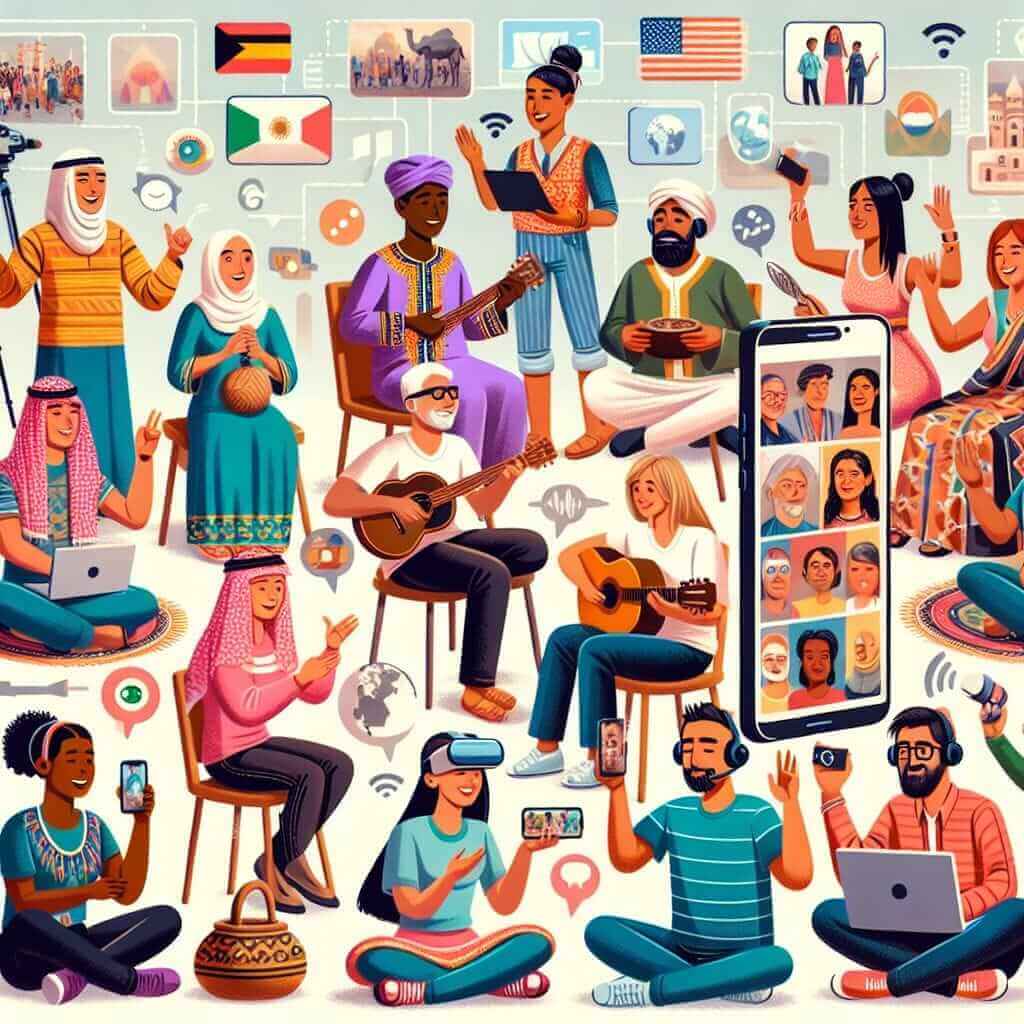The topic of the influence of technology on cultural exchange has become increasingly prevalent in recent years, especially in IELTS Writing Task 2. This trend is driven by rapid advancements in technology and globalization. Past IELTS exam questions frequently touch upon themes like global trade, digital art’s impact on traditional art forms, and cultural heritage in modern society. Given its relevance, it is highly likely that similar topics will appear in future exams.
Example Past IELTS Questions:
- “To what extent does technology influence cultural exchange among people?”
- “Discuss the benefits and drawbacks of technological advancements on cultural diversity.”
For this analysis and writing task, I’ll use a themed question related to technology and cultural exchange to provide a model answer.
Selected Task Question
“To what extent has technology facilitated intercultural communication and exchange? Discuss both the advantages and disadvantages of this development.”
Analyzing the Question
The question asks about the extent to which technology has facilitated intercultural communication and exchange. It also requests an examination of both the advantages and disadvantages of this phenomenon. Therefore, a balanced approach discussing both positives and negatives is necessary.
Model Essay
Introduction:
In recent years, technology has significantly impacted intercultural communication and cultural exchange. By breaking down geographic and linguistic barriers, it has made it easier for people worldwide to connect and share their cultural heritage. However, this development also has its downsides. This essay will explore both the advantages and disadvantages of technological advancements on cultural exchange.
Body Paragraph 1: Advantages
One of the primary benefits of technology in facilitating cultural exchange is the ease of communication it provides. Social media platforms, for instance, allow people from different cultures to share information, ideas, and traditions effortlessly. Platforms like Facebook, Instagram, and Twitter enable users to exchange images, videos, and texts, enriching their understanding of diverse cultures. Additionally, technology has made language translation tools more accessible, breaking down linguistic barriers that once hindered intercultural interactions. Services like Google Translate or language learning apps like Duolingo have simplified the process of learning new languages, making communication between different ethnicities more seamless.
Moreover, virtual reality (VR) and augmented reality (AR) technologies offer immersive experiences, allowing people to explore different cultures virtually. For example, VR tours of historic sites or AR cultural exhibitions enable users to experience cultural artifacts and places without physically being there. E-learning platforms also contribute by offering courses on various cultural studies, allowing learners globally to access high-quality education on different traditions and customs.
Body Paragraph 2: Disadvantages
Despite these advantages, there are significant drawbacks to consider. One major issue is the reduction in face-to-face interactions. Over-reliance on digital communication can lead to superficial relationships, where the depth of cultural understanding is limited. Virtual interactions often lack the nuance and personal connection that real-life interactions provide, which can result in miscommunication and misunderstandings.
Furthermore, the proliferation of technology has facilitated the spread of cultural homogenization, where dominant cultural norms overshadow local traditions. For instance, the global influence of Western culture through digital platforms often dilutes unique cultural identities, leading to a loss of cultural diversity. Additionally, the digital divide remains a critical issue. Not everyone has equal access to technology, which creates disparities in cultural exchange opportunities. People in underdeveloped regions may not benefit from these technological advancements, further widening the cultural gap between societies.
Conclusion:
In conclusion, technology has undoubtedly facilitated intercultural communication and cultural exchange by making it easier for people to connect and share their cultural heritage. However, it also comes with its challenges, including reduced face-to-face interactions, cultural homogenization, and unequal access to technology. Balancing these advantages and disadvantages is crucial to ensuring that technology contributes positively to cultural diversity.

Word count: 403 words
Important Points to Remember When Writing This Essay
- Use appropriate vocabulary and grammar: Ensure that your essay includes varied vocabulary and complex sentence structures.
- Maintain a balanced approach: Discuss both sides of the argument equally to demonstrate critical thinking.
- Use relevant examples: Incorporate real-life examples to make your points more compelling.
Key Vocabulary to Remember
- Facilitate (verb) /fəˈsɪl.ɪ.teɪt/: To make something easier or more likely to happen.
- Barrier (noun) /ˈbær.i.ər/: An obstacle that prevents movement or access.
- Homogenization (noun) /həˌmɒdʒ.ɪ.naɪˈzeɪ.ʃən/: The process of making things uniform or similar.
- Nuance (noun) /ˈnjuː.ɑːns/: A subtle difference in meaning, expression, or sound.
- Proliferation (noun) /prəˌlɪf.ərˈeɪ.ʃən/: Rapid increase in number or spread.
- Disparity (noun) /dɪˈspær.ə.ti/: A great difference.
- Immersive (adjective) /ɪˈmɜː.sɪv/: Creating an experience that surrounds the user.
- E-learning (noun) /ˈiː.lɜː.nɪŋ/: Learning conducted via electronic media, typically on the Internet.
- Miscommunication (noun) /ˌmɪs.kəˌmjuː.nɪˈkeɪ.ʃən/: Failure to communicate clearly.
- Linguistic (adjective) /lɪŋˈɡwɪs.tɪk/: Relating to language or linguistics.
Conclusion
To summarize, the influence of technology on cultural exchange is a pertinent topic in the IELTS Writing Task 2. It’s critical to approach this subject by evaluating both the positive and negative impacts of technology. Additionally, practice writing essays on similar topics, such as “the impact of global trade on cultural exchange” or “the role of education in promoting cultural understanding”, to enhance your skills and preparedness for the exam.
For more related topics, check out:
The Influence of Global Trade on Cultural Exchange
The Role of Education in Promoting Cultural Understanding